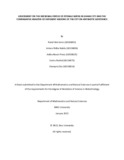| dc.contributor.advisor | Ahmed, Akash | |
| dc.contributor.advisor | Haque, Fahim Kabir Monjurul | |
| dc.contributor.author | Amin, Rahaf Bint | |
| dc.contributor.author | Nabila, Antara Ridha | |
| dc.contributor.author | Prova, Adiba Hasan | |
| dc.contributor.author | Rashid, Samia | |
| dc.contributor.author | Das, Devopria | |
| dc.date.accessioned | 2023-04-03T07:44:53Z | |
| dc.date.available | 2023-04-03T07:44:53Z | |
| dc.date.copyright | 2022 | |
| dc.date.issued | 2022-01 | |
| dc.identifier.other | ID 18336002 | |
| dc.identifier.other | ID 18336006 | |
| dc.identifier.other | ID 18336025 | |
| dc.identifier.other | ID 18136073 | |
| dc.identifier.other | ID 18336016 | |
| dc.identifier.uri | http://hdl.handle.net/10361/18067 | |
| dc.description | This thesis is submitted in partial fulfillment of the requirements for the degree of Bachelor of Science in Biotechnology 2022. | en_US |
| dc.description | Catalogued from PDF version of thesis. | |
| dc.description | Includes bibliographical references (pages 45-48). | |
| dc.description.abstract | Dhaka City is home to nearly 22,478,000 people, but accessible drinking water sources are limited.
Moreover, the minimal available water sources are polluted, rendering the Dhaka City population victim
of water-borne health hazards. The key water source examined in this study is the community water from
street food vendors all over Dhaka City, which is consumed by general people on a regular basis. A total
of 47 water samples were collected from tea stalls, street food vendors, and roadside restaurants and the
samples were processed within 2 hours of collection. A combination of spread, pour and streak plating
methods were used on a variety of selective media, such as MAC, XLD, MSA, TCBS, M-FC, etc. Gram
staining and an array of biochemical tests were also performed to identify the target organisms. Antibiotic
Susceptibility was further performed to examine the level of antibiotic resistance. In this study, Bacillus
spp was the most prevalent (28.57%) bacteria isolated from drinking water. E.coli was found to be the
highest one (12%) among a myriad of other enteric pathogens. However, a distressing number of fecal
coliforms were found in more or less all the samples The isolates showed highest resistance to Penicillin
80.67% followed by Colistin 50.42%, Cefepime 23.52%, Gentamicin 42.01%, Cefuroxime 43.69%,
Erythromycin 24.36%. Diseases related to the serious contamination of drinking water in Dhaka city
constitute a major burden on human health and can cause a leading risk factor for infectious diseases
including cholera, diarrhea, dysentery and typhoid. | en_US |
| dc.description.statementofresponsibility | Rahaf Bint Amin | |
| dc.description.statementofresponsibility | Antara Ridha Nabila | |
| dc.description.statementofresponsibility | Adiba Hasan Prova | |
| dc.description.statementofresponsibility | Samia Rashid | |
| dc.description.statementofresponsibility | Devopria Das | |
| dc.format.extent | 61 pages | |
| dc.language.iso | en | en_US |
| dc.rights | Brac University theses are protected by copyright. They may be viewed from this source for any purpose, but reproduction or distribution in any format is prohibited without written permission. | |
| dc.subject | Biochemical identification | en_US |
| dc.subject | Antibiotic susceptibility test | en_US |
| dc.subject | Potable water | en_US |
| dc.subject | Antibiotic resistance | en_US |
| dc.subject.lcsh | Water--Purification | |
| dc.title | Assessment on the microbial status of potable/ drinking water in Dhaka city and the comparative analysis of different regions of the city on antibiotic resistance | en_US |
| dc.type | Thesis | en_US |
| dc.contributor.department | Department of Mathematics and Natural Sciences, Brac University | |
| dc.description.degree | B. Biotechnology | |

